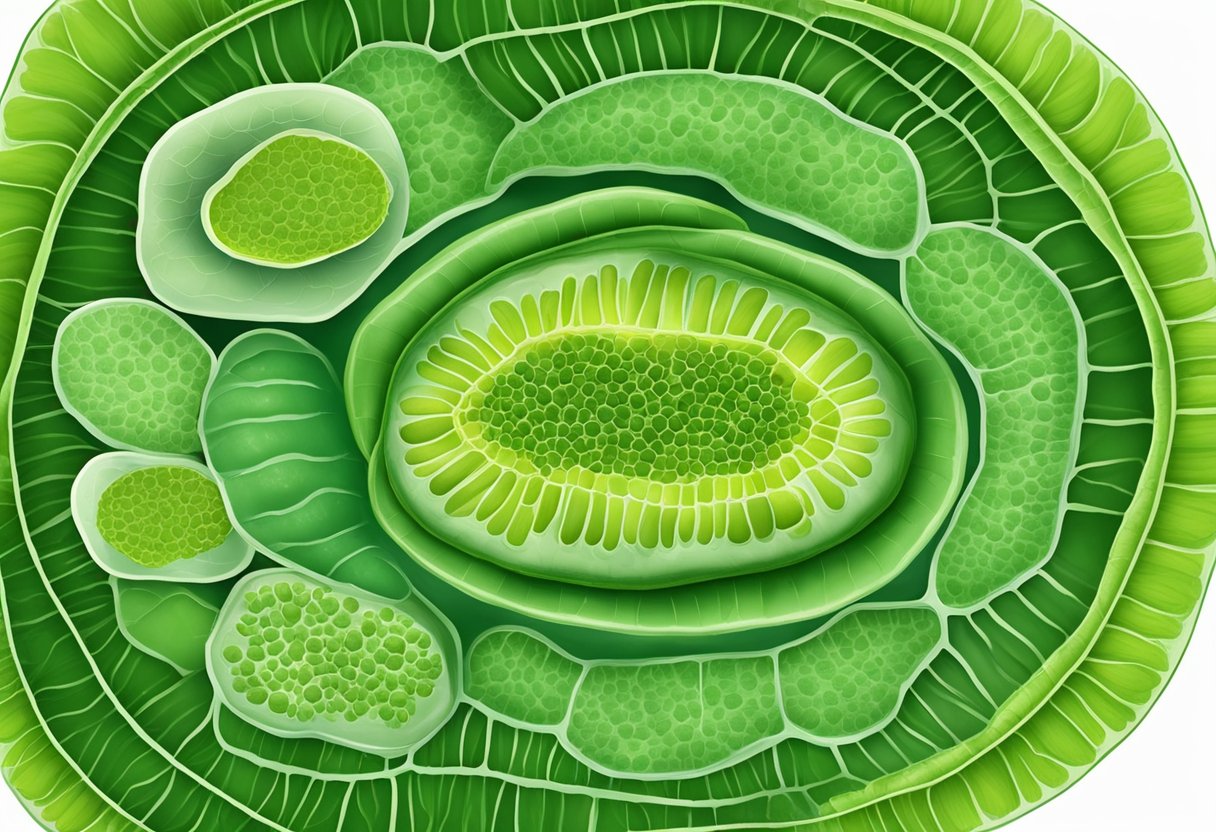Types Of Cells that Contain Chloroplasts
Chloroplasts are organelles found in plant cells that are responsible for the process of photosynthesis. They contain chlorophyll, a pigment that absorbs light energy and converts it into chemical energy that can be used by the plant. While chloroplasts are most commonly associated with plant cells, there are actually several different types of cells that contain chloroplasts.
One type of cell that contains chloroplasts is the leaf cell. Leaf cells are specialized cells that are designed to capture sunlight and use it to produce energy through photosynthesis. Chloroplasts are found in large numbers in leaf cells, and they are responsible for the green color of the leaves.
Another type of cell that contains chloroplasts is the stem cell. While stem cells are not typically associated with photosynthesis, there are some types of plants that have stem cells that contain chloroplasts. In these plants, the stem cells help to produce energy and support the growth of the plant.
Key Takeaways
- Chloroplasts are organelles found in plant cells that are responsible for photosynthesis.
- Leaf cells and stem cells are two types of cells that contain chloroplasts.
- Chloroplasts are responsible for the green color of leaves and can help to produce energy in stem cells.
Chloroplast Structure and Function

Chloroplasts are organelles that are found in plant cells and some other eukaryotic organisms. They are responsible for conducting photosynthesis, which is the process by which light energy is converted into chemical energy. Chloroplasts are surrounded by a double membrane, and they contain several internal structures that are involved in photosynthesis.
Chloroplast Membranes
The outer membrane of the chloroplast is smooth and permeable. It is responsible for protecting the chloroplast from damage and for regulating the movement of molecules into and out of the organelle. The inner membrane is more selectively permeable than the outer membrane, and it is involved in transporting molecules into and out of the chloroplast.
Thylakoid System
The thylakoid system is a series of interconnected membranes that are found within the chloroplast. The thylakoids are arranged in stacks called grana, and they contain a variety of pigments, including chlorophyll, which are involved in capturing light energy. The thylakoid membranes are also involved in the electron transport chain, which is responsible for generating ATP, the energy currency of the cell.
Stroma Functionality
The stroma is the fluid-filled region that is found between the thylakoid membrane and the inner membrane of the chloroplast. It contains a variety of enzymes that are involved in the synthesis of organic compounds, including glucose and other sugars. The stroma is also involved in the Calvin cycle, which is the process by which carbon dioxide is converted into organic compounds.
In conclusion, chloroplasts are organelles that are responsible for conducting photosynthesis in plant cells and some other eukaryotic organisms. They are surrounded by a double membrane and contain several internal structures that are involved in photosynthesis. The thylakoid system is a series of interconnected membranes that are involved in capturing light energy and generating ATP, while the stroma is involved in the synthesis of organic compounds.
Photosynthesis and Energy Conversion
Chloroplasts are organelles found in plant cells that are responsible for photosynthesis, the process by which light energy is converted into chemical energy. Photosynthesis occurs in two main stages: the light-dependent reactions and the light-independent reactions, also known as the Calvin cycle.
The Light Reactions
The light-dependent reactions occur in the thylakoid membranes of the chloroplasts. The process begins with the absorption of light by chlorophyll, a pigment found in the thylakoid membranes. The absorbed light energy is then used to split water molecules into oxygen and hydrogen ions. The oxygen is released into the atmosphere, while the hydrogen ions are used to create a proton gradient across the thylakoid membrane.
This proton gradient is used to generate ATP, the energy currency of the cell. The electrons released from the water molecules are also used to create NADPH, another energy-rich molecule that is used in the Calvin cycle.
Calvin Cycle and Carbon Fixation
The Calvin cycle, also known as the light-independent reactions, occurs in the stroma of the chloroplasts. The cycle begins with the fixation of carbon dioxide, which is converted into organic molecules using the energy from ATP and NADPH generated during the light-dependent reactions.
The Calvin cycle is a complex process that involves a series of enzyme-catalyzed reactions. The end result is the production of glucose, a sugar that is used by the plant cell as a source of energy.
Overall, photosynthesis is a critical process for the survival of plants and other organisms that rely on them for food. By converting light energy into chemical energy, chloroplasts are able to produce the organic molecules that are necessary for life.
Cell Types with Chloroplasts
Chloroplasts are organelles found in cells that enable photosynthesis. Photosynthesis is the process by which plants, algae, and some bacteria convert sunlight into energy. Chloroplasts are found in various cell types, including plant cells, algae, and photosynthetic bacteria.
Plant Cell Types
Plant cells are eukaryotic cells containing chloroplasts. Chloroplasts are found in various plant tissues, including leaves, stems, and flowers. In leaves, chloroplasts are found in the mesophyll cells, which are located between the upper and lower epidermis. Chloroplasts are also found in the guard cells, which regulate the opening and closing of stomata.
Algae and Their Varieties
Algae are a diverse group of aquatic organisms that contain chloroplasts. Chloroplasts in algae are similar to those found in plant cells. Algae are classified into different groups based on their pigmentation, cell wall structure, and other characteristics. Some common types of algae that contain chloroplasts include green algae, red algae, and brown algae.
Photosynthetic Bacteria
Photosynthetic bacteria are a group of bacteria that contain chlorophyll and other pigments that enable photosynthesis. Photosynthetic bacteria are classified into different groups based on their pigmentation, cell wall structure, and other characteristics. Some common types of photosynthetic bacteria that contain chloroplasts include cyanobacteria and purple bacteria.
In all of these cell types, chloroplasts contain a small genome that is distinct from the cell’s nuclear genome. The chloroplast genome contains genes that are involved in photosynthesis and other chloroplast functions. Chloroplasts are also surrounded by a double membrane that separates the chloroplast from the cytoplasm of the cell.
In conclusion, chloroplasts are found in various cell types, including plant cells, algae, and photosynthetic bacteria. Chloroplasts contain a small genome and are surrounded by a double membrane. Chloroplasts are essential for photosynthesis, which is the process by which plants, algae, and some bacteria convert sunlight into energy.
Chloroplast Genetics and Biogenesis
Chloroplast DNA
Chloroplasts possess their own DNA, known as chloroplast DNA or cpDNA. The chloroplast genome is circular and has a size of approximately 120-160 kilobase pairs. It contains genes that encode proteins and RNAs that are involved in photosynthesis, carbon fixation, and other essential chloroplast functions. The cpDNA is inherited maternally in most plant species, and its replication is coordinated with the cell cycle of the host cell.
Protein Synthesis and Import
Chloroplasts have their own ribosomes that synthesize proteins from the genes encoded in the cpDNA. However, the majority of chloroplast proteins are synthesized in the cytoplasm and are imported into the organelle. The import of chloroplast proteins is a complex process that involves several protein translocons located in the chloroplast envelope membranes. The targeting of proteins to the chloroplast is mediated by specific amino acid sequences called transit peptides, which are cleaved off after import.
Chloroplast Division and Inheritance
Chloroplasts divide by binary fission, similar to bacteria, and their division is regulated by a set of proteins encoded in both the chloroplast and nuclear genomes. The inheritance of chloroplasts is usually maternal, and the organelles are distributed randomly among the daughter cells during cell division. However, in some plant species, paternal chloroplasts can also be transmitted to the offspring.
Overall, chloroplast genetics and biogenesis are essential processes that ensure the proper functioning and inheritance of this organelle. The coordination between the chloroplast and nuclear genomes is crucial for the expression of chloroplast genes and the import of cytoplasmic proteins into the organelle.
Evolutionary Origin of Chloroplasts
Endosymbiotic Theory
The evolutionary origin of chloroplasts is a subject of intense study and debate. The most widely accepted theory is the endosymbiotic theory, which suggests that chloroplasts originated from a free-living cyanobacterium that was engulfed by a eukaryotic host cell. This symbiotic relationship eventually led to the formation of a new organism, the photosynthetic eukaryote.
According to the endosymbiotic theory, the chloroplast was once a free-living cyanobacterium that was engulfed by a non-photosynthetic eukaryotic cell. Over time, the cyanobacterium evolved into a specialized organelle that was capable of photosynthesis. This process is known as endosymbiosis.
Evidence of Chloroplast Evolution
There is a significant amount of evidence to support the endosymbiotic theory of chloroplast evolution. One of the most compelling pieces of evidence is the fact that chloroplasts have their own DNA, which is similar to that of free-living cyanobacteria. This suggests that the chloroplasts were once independent organisms that were later engulfed by a host cell.
Another piece of evidence is the fact that chloroplasts have a double membrane, which is similar to that of other organelles that are thought to have originated through endosymbiosis, such as mitochondria. The outer membrane of the chloroplast is thought to be derived from the host cell’s plasma membrane, while the inner membrane is thought to be derived from the cyanobacterium’s plasma membrane.
In addition, chloroplasts and cyanobacteria share many of the same genes, which further supports the idea that chloroplasts evolved from a cyanobacterium that was engulfed by a eukaryotic host cell. These shared genes include those that are involved in photosynthesis, such as those that encode for the light-harvesting complexes and the photosynthetic reaction centers.
Overall, the endosymbiotic theory provides a compelling explanation for the evolutionary origin of chloroplasts. The evidence suggests that chloroplasts evolved from a free-living cyanobacterium that was engulfed by a eukaryotic host cell, eventually leading to the formation of a new organism that was capable of photosynthesis.






